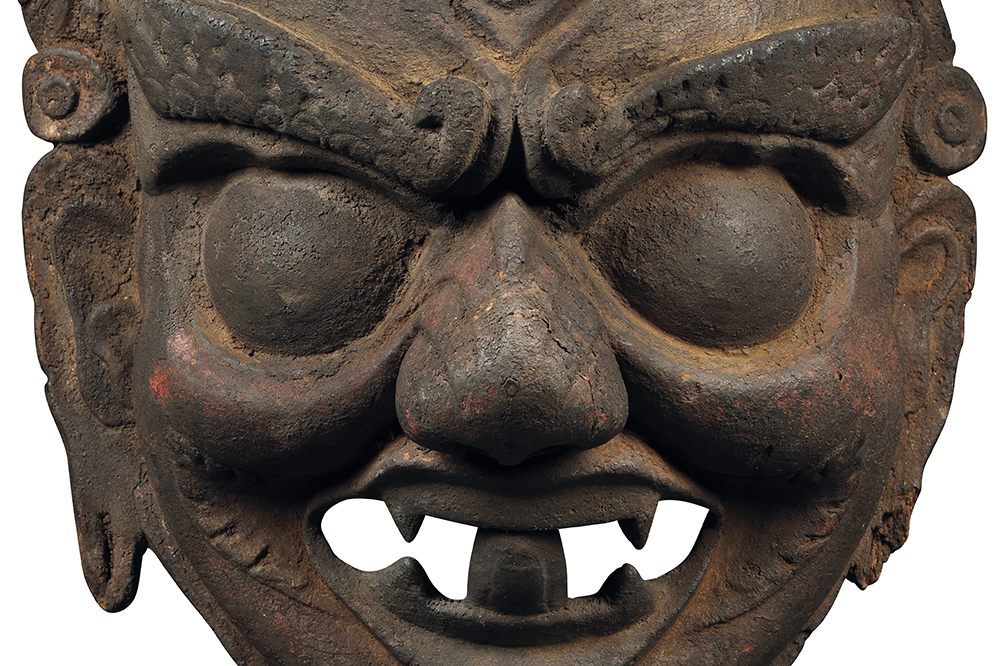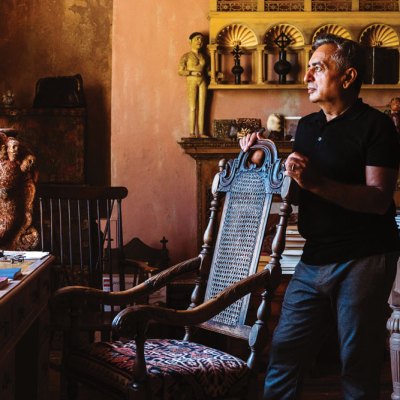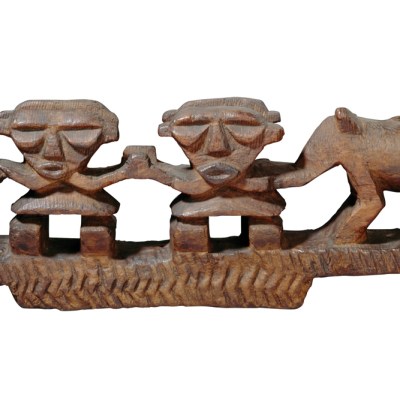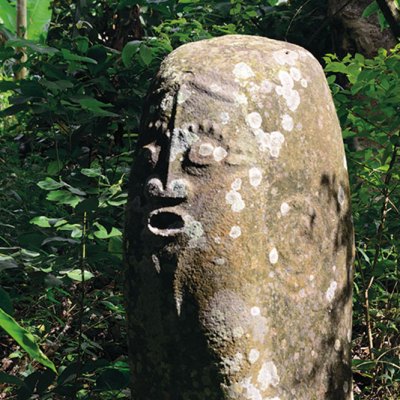From the July/August 2024 issue of Apollo. Preview and subscribe here.
The French dealer Frédéric Rond, a regular participant at Parcours des Mondes, sums up his special interest: ‘Himalayan tribal art is a relatively young market and it is probably the last tribal avant-garde.’ It is indeed a new field of interest for collectors – European dealers began travelling in the Himalayas only in the early 1970s, after the first road connecting Nepal to India was completed in 1963. Attuned to the affinity between some artistic traditions found in Africa and Oceania and the 20th-century avant-garde, they spotted a similar aesthetic and spiritual power in certain objects they were seeing in Kathmandu’s markets. The Milan-based dealer Renzo Freschi took the overland route to Nepal in 1971; in his 2017 introduction to the exemplary collection of Himalayan masks owned by the Swiss collector Luciano Lanfranchi, Freschi describes the moment in 1975 when, in the main square of Basantapur, Kathmandu, teeming ‘with sellers of ancient marvels, jewellery, wood carvings, masks, furnishings, ritual objects, illuminated books, sacred images’, some unusual masks appeared. ‘Completely different,’ he reports, from the classical Buddhist monastic masks of Tibet, these were ‘covered in hair, with extraordinary shiny patinas supporting fierce or dazed expressions […] No-one knew or was willing to reveal where they came from.’ From this experience a market was born, shaped by European and North American fascination with these objects.
The Turin-based writer Fausto Doro first drew public attention to these masks in 1974. Freschi, along with a small number of dealers and enthusiasts from France, Italy and the United States, began investigating this new field. The first exhibition in the West devoted to Nepalese art opened in 1981 at L’Ile du Démon gallery, which specialised in Indonesian art. Meanwhile Freschi visited temples and local scholars, who denied that the masks were used in shamanistic rituals but explained that they might be used for masked theatrical performances in communities with a range of animistic, Buddhist and Hindu beliefs. This inspired Freschi to organise an exhibition on Nepalese masks at Milan’s Centro Ricerche Teatrali in 1984. The same year, François Pannier opened his gallery Le Toit du Monde in Paris. ‘These objects then had no history,’ Pannier explains. ‘I decided to research it.’
Mask (c. 1800), Magar people, west Nepal. Indian Heritage – Frédéric Rond (price on application). Photo: Frédéric Rond
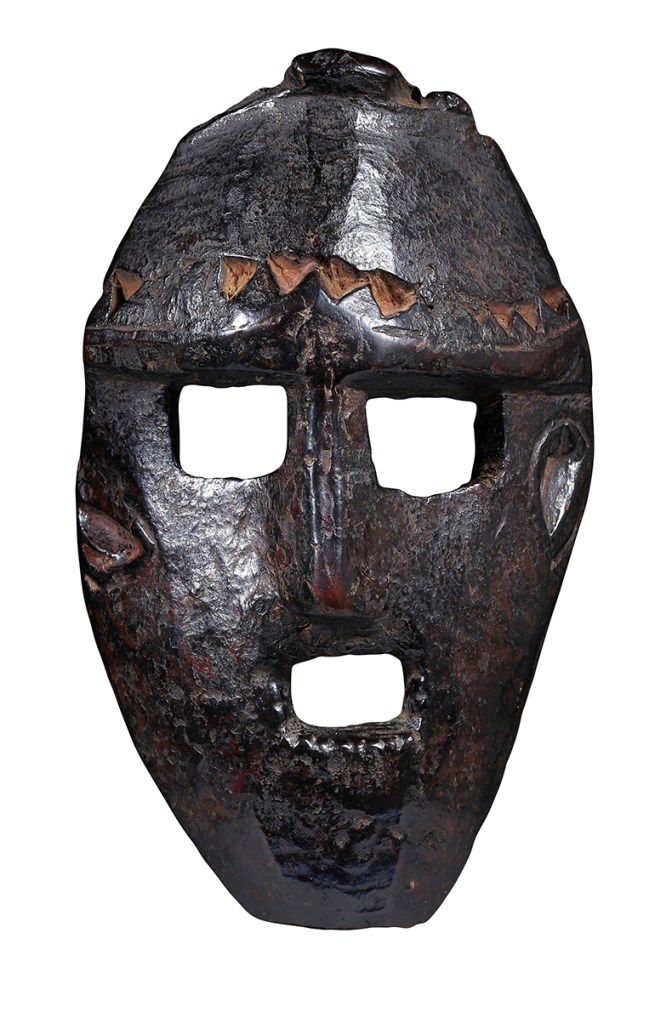
Among the American players was Thomas Murray, a specialist in Indonesian art and masks. Murray recalls, late in 1985, arriving at his usual Sunday rendezvous at Sausalito Flea Market, north of the Golden Gate Bridge, which thronged each week with young people selling Nepalese and Indian artefacts acquired on the hippy trail. His friend the sculptor Mort Golub had already bought a magnificent mask, fresh from Nepal, for $600. The two agreed to build a collection together.
Pannier organised the first public exhibition in Paris of Himalayan masks in 1988, while Lawrence Hultberg, a gallerist, and Eric Chazot, a specialist in the art of Nepal and Tibet, organised the Smithsonian’s first public touring exhibition of Nepalese masks in the United States in 1989. Rond points out that ‘Until recently, local and Occidental scholarly research was mostly focused on Buddhism and Hinduism, not on the tribal rituals.’ The market for shamanistic and animistic art, in contrast with art informed by Buddhist and Hindu traditions, grew organically as an enthusiasm shared by dealers and collectors. Murray says that ‘Until 1995, connoisseurship was democratic’, with different morphologies, chronologies and contextual analyses being undertaken by dealers and collectors. Gradually the canon expanded to include Monpa and Sherdukpen masks from the eastern Himalayas, masks from Himachal Pradesh and Uttarakhand (north and north-western India), and anthropomorphic guardian figures from western Nepal. There are also ritual objects – wooden daggers, drums – and wooden butter-making utensils or ghurras. Dating is always difficult for wooden objects, which are generally assumed to be late 19th century, although some Nepalese masks have been carbon-dated to much earlier. As Murray says, ‘In the Himalayas, the air is dry. If 15th-century silk thangkas can survive, why shouldn’t highly patinated masks be old?’
Ritual mask (early 20th century), Middle Hills, Nepal. Renzo Freschi – Asian Art (price on application). Photo: courtesy Renzo Freschi – Asian Art
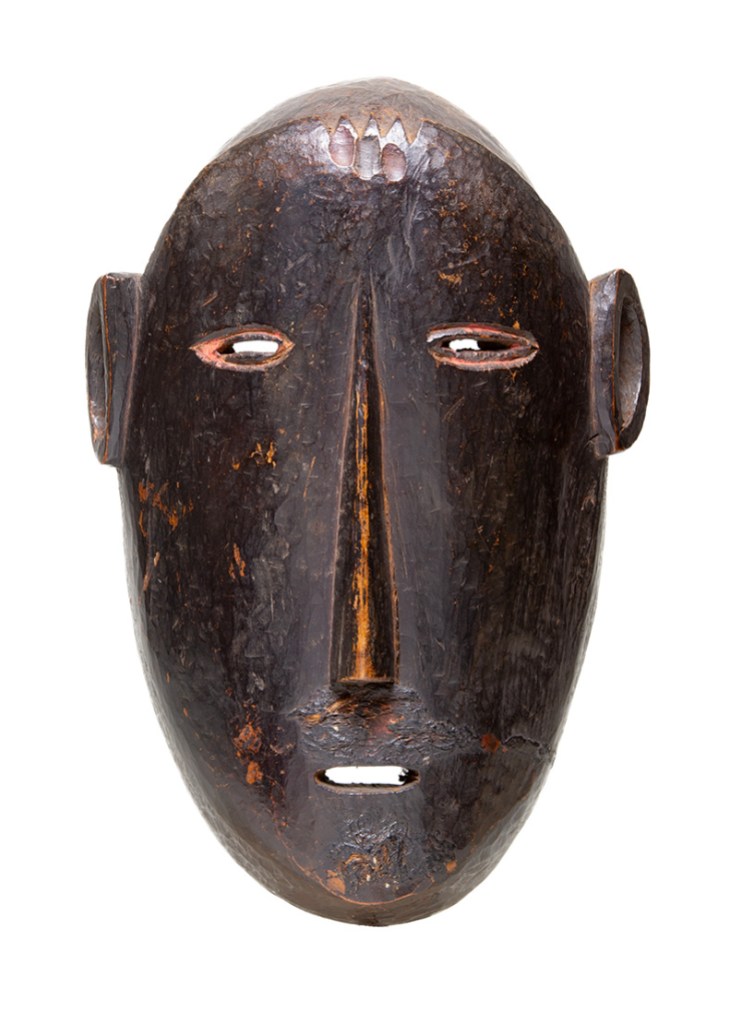
For a decade, Freschi reports, the market and public exposure dipped, even as research and private collecting continued. But in the late 2000s interest was reignited by exhibitions of private collections and the establishment of important public holdings, including at the Musée de la Castre in Cannes (renamed the Musée des explorations du monde in 2021 and recently enhanced by a large donation from Pannier) and the Marc Petit collection at the Musée du quai Branly in Paris. Today, Edward Wilkinson, global head of Indian, Himalayan & Southeast Asian Art at Bonhams, confirms, ‘This is a very strong and dedicated market […] conducted largely between the trade and collector to collector.’ The best source of information is the website Ethnoflorence, established by the US-based collector Gian Marco Matteuzzi in 2008, which collates news, information and images. Matteuzzi suggests the market needs an organised digital archive, in an academic institution, for it to mature. ‘Aesthetic standards are still difficult to establish,’ he says, ‘and those proposed often “suffer” from comparison with those of traditional African arts.’
Wilkinson concurs that establishing hierarchies of value is difficult, since these objects rarely reach the major auction rooms. Those that do are typically masks, sold in Paris and Brussels. The most significant recent prices have been the €32,500 achieved for a striking mask from the Middle Hills of Nepal, sold at Sotheby’s, Paris, in 2018 (estimate €15,000– €25,000) and a similar mask sold in June 2014 for €43,500 (estimate €40,000–€50,000). However, dealers say that the best pieces can reach €100,000. Murray comments that those which are more asymmetric, reflecting ‘a chaotic sensibility’, appeal to the French, while American collectors, especially those with an interest in classical Buddhist art, tend towards what he refers to as ‘classical monastic’ masks, such as the red-faced Mahakala that he currently has available for $28,000, once in the collection of the publisher Felix Dennis. Murray suggests that ‘at their best’, the ‘village’ Monpa masks from the Bhutan/India border ‘are available to both camps’. But what really matters to collectors is the patina. ‘The patina that is most prized is one that develops over centuries, from soot and butter fat. That speaks to the efficacy of the mask. Those with highlights of shine and lustre are highly desirable,’ Murray says.
Red-faced Mahakala (19th century or earlier), Tibet, Bhutan or Nepal. Thomas Murray Gallery ($28,000). Photo: Scott McCue

Today, Freschi says, ‘the market is concentrated in the West. I do not buy from Nepalese dealers today. I doubt the authenticity of pieces.’ At one time, many carried a red wax seal indicating that an export permit had been obtained from Nepalese authorities, but until the 1990s there were few restrictions on export, since little value was placed on these pieces. They were always rare finds, however, so there are few in the market. Freschi reports that today collectors are interested only in ‘authentic, old pieces’. Most are collectors of ethnographic art more generally: ‘They feel the Himalayan pieces offer good value and are part of the story.’ He has available an early 20th-century ritual mask from the Middle Hills of Nepal and a protector from the 19th century from Karnali in west Nepal, with a thick patina.
Pannier notes that younger collectors and dealers are not entering the field because the starting price for good pieces is too high. Rond is bucking the trend: a relatively new entrant to the market, at the Paris Tribal show this April he sold an old and expressive tribal mask from the Kirant people of east Nepal which represents a joker: ‘The character of the joker is mocked but also feared as it is meant to make a link between gods and humans,’ he explains. He adds that another object he has available, a mask from the Magar people of west Nepal, ‘is a good example of what collectors seek these days’. He says, ‘The main criterion is still the emotion you feel when you look at a mask. Age, cut and provenance are important, but the main criterion is something very subtle.’
From the July/August 2024 issue of Apollo. Preview and subscribe here.
